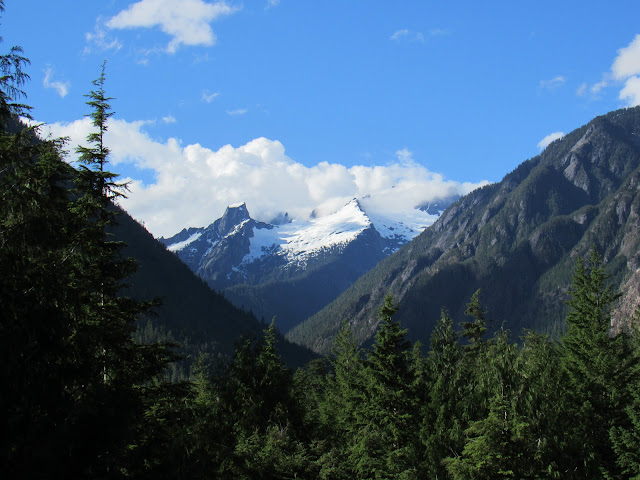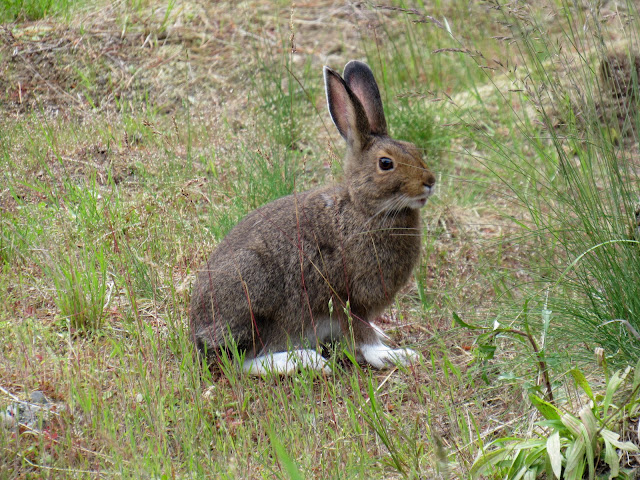The Mountains are Calling: North Cascades
For even more staggering mountain beauty, we made our way northeast from Olympic National Park, to North Cascades National Park, via idyllic Whidbey Island and the Skagit River Valley.
Catch up on our entire trip here!
Way back in June, we spent 3 nights camping (and birding) in the North Cascades: here is just a small peek at what we found along the way!
The most common birds we encountered were American Robins, Western Tanagers, Pacific Wrens, Hammond's Flycatchers, White-crowned Sparrows, Hairy Woodpeckers, Red-breasted Sapsuckers, Violet-green Swallows, and Swainson's, Varied and Hermit Thrushes.
 |
| Probably the best bird photo from the entire trip: an ordinary White-crowned Sparrow! |
We also heard warblers galore - Black-throated Gray, Wilson's, MacGillivray's, Townsend's, Yellow, Yellow-rumped - and a handful of Red-eyed Vireos, which we never did actually see, hidden as they were high in the treetops.
 |
| A colorful Western Tanager |
Warbling Vireos and Lazuli Buntings sang from Riparian areas, Cedar Waxwings hung out in the cedar trees, and Canada Jays were busy raising their rowdy young at higher elevations, despite the snow! Feisty Rufous Hummingbirds vied over the rights to a blooming patch of salal right outside our tent, and from the trees behind our campsite, a Northern Pygmy-owl called at dawn.
 |
| Cedar Waxwing |
We spotted quite a few Vaux's Swifts, and - most excitingly - Black Swifts and a pair of Common Nighthawks, coursing through the sky above the river valley.
 |
| The view from the Sterling Munro viewpoint near the visitor center in Newhalem: stunning scenery, and also the site of our swift and nighthawk sightings! |
But by far the most exciting birding adventure of our entire Pacific Northwest trip was our quest to find the American Three-toed Woodpecker!!
I'm not making it up: that is the real name of an actual bird, Picoides dorsalis, a woodpecker of coniferous forests of the Rocky Mountains, Alaska and Canada.
Three-toed Woodpeckers prefer forest habitat that has been damaged by fires, floods or windstorms, resulting in a high number of standing dead snags, which are infested with insects (woodpecker food) and decaying hollows perfect for breeding sites. Typically solitary outside the breeding season, American Three-toed Woodpeckers are small and fairly quiet. These birds breed farther north than any other North American woodpecker, but a tiny sliver of their range extends down into the Cascades. According to eBird, a couple of these woodpeckers had been seen/heard recently from a dirt parking area just off the main highway through North Cascades, an area that burned a number of years ago.
This obscure spot was our destination.
But, as luck would have it, it was pouring rain when we arrived. As you might guess, rain is not good birding weather, for multiple reasons. We decided to try to wait it out... sitting in the car... to no avail. We gave up. After a 40 minute drive back down the mountain, we had our lunch and cast around for a while, somewhat dejectedly, waiting for the weather to clear up at the higher elevations.
Mid-afternoon, Eric made the final decision: we would drive back up the mountain to the woodpecker spot and try again. So that is exactly what we did. By this time, the rain had cleared up, the sun was peeking out from the clouds, and the birds were singing in earnest. Once back at the spot, we spent close to an hour wandering slowly, quietly along the edge of the woods, listening intently for anything that sounded vaguely woodpeckerish, particularly pik calls or drumming. Long minutes ticked past and we heard nothing.
As the evening wore on, we were just about ready to call it a day and give up. We were just about to get into the car, when I heard it: a very distinctive, though faint, pik, a pik unlike that of other woodpeckers. That was all the encouragement I needed! I was off, quickly but carefully and very quietly, hurrying - slowly - up the hill through the forest, plunging into the trees with only one object before me: the American Tree-toed Woodpecker! Luckily, the ground was damp and spongy, a soft carpet of moss over a deep bed of decaying logs and forest duff; moving quietly was easy.
 |
| Eric snapped this blurry, Sasquatch-like photo of me... just as I found the bird! |
The dance was familiar to me: step, step, pause, listen. Hold very still. Listen very hard. Pik! There it is! Step, step, step, pause again, listen harder. Pik! There it is again! Closer this time! And so on, up, up, up the hill, deeper and deeper into the forest until all I could see in any direction were trees, endless trunks of trees and logs and moss. The call would stop, for a minute or longer, and I would wait, silently, wondering if I should press on, closer to the source of the most recent sound, or stay put, waiting for the bird to call again. At times like this, the mind begins to play tricks: I did hear it, right? Yes, I'm sure I did! Didn't I?
After what seemed like ages of silence, I heard the call again and pressed on.
Chasing birds in this fashion is both agonizing and exhilarating: by the time I caught my first glimpse of the bird, I was shaking! But there it was, quietly flaking away bark and emitting soft pik calls: my first American Three-toed Woodpecker!
 |
| A less-than-ideal, but recognizable photo of an American Three-toed Woodpecker! |
We watched the bird for four or five minutes before it flew deeper into the forest, but it was enough time for Eric to climb up the hill behind me and get a good look at it too! After all, it's only because of his determination and willingness to drive back up mountain that we were able to find it!
For those keeping track... the American Three-toed Woodpecker was the 19th species of North American woodpeckers to add to my list. Only three more to go and I will have seen all 22 species!
 |
| Blurry... but unmistakable! |










Comments
Post a Comment